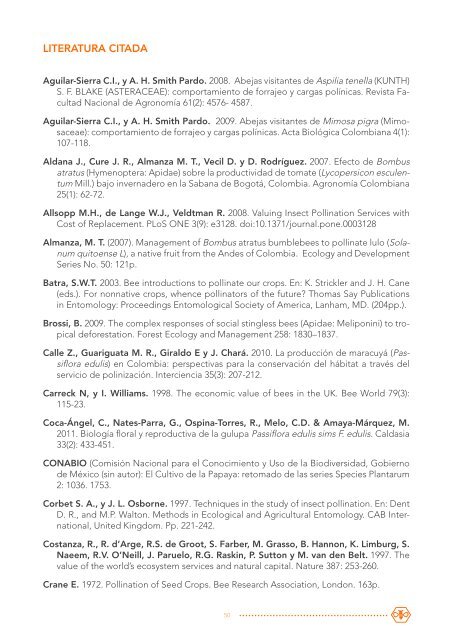1oymNiy
1oymNiy
1oymNiy
You also want an ePaper? Increase the reach of your titles
YUMPU automatically turns print PDFs into web optimized ePapers that Google loves.
LITERATURA CITADAAguilar-Sierra C.I., y A. H. Smith Pardo. 2008. Abejas visitantes de Aspilia tenella (KUNTH)S. F. BLAKE (ASTERACEAE): comportamiento de forrajeo y cargas polínicas. Revista FacultadNacional de Agronomía 61(2): 4576- 4587.Aguilar-Sierra C.I., y A. H. Smith Pardo. 2009. Abejas visitantes de Mimosa pigra (Mimosaceae):comportamiento de forrajeo y cargas polínicas. Acta Biológica Colombiana 4(1):107-118.Aldana J., Cure J. R., Almanza M. T., Vecil D. y D. Rodríguez. 2007. Efecto de Bombusatratus (Hymenoptera: Apidae) sobre la productividad de tomate (Lycopersicon esculentumMill.) bajo invernadero en la Sabana de Bogotá, Colombia. Agronomía Colombiana25(1): 62-72.Allsopp M.H., de Lange W.J., Veldtman R. 2008. Valuing Insect Pollination Services withCost of Replacement. PLoS ONE 3(9): e3128. doi:10.1371/journal.pone.0003128Almanza, M. T. (2007). Management of Bombus atratus bumblebees to pollinate lulo (Solanumquitoense L), a native fruit from the Andes of Colombia. Ecology and DevelopmentSeries No. 50: 121p.Batra, S.W.T. 2003. Bee introductions to pollinate our crops. En: K. Strickler and J. H. Cane(eds.). For nonnative crops, whence pollinators of the future? Thomas Say Publicationsin Entomology: Proceedings Entomological Society of America, Lanham, MD. (204pp.).Brossi, B. 2009. The complex responses of social stingless bees (Apidae: Meliponini) to tropicaldeforestation. Forest Ecology and Management 258: 1830–1837.Calle Z., Guariguata M. R., Giraldo E y J. Chará. 2010. La producción de maracuyá (Passifloraedulis) en Colombia: perspectivas para la conservación del hábitat a través delservicio de polinización. Interciencia 35(3): 207-212.Carreck N, y I. Williams. 1998. The economic value of bees in the UK. Bee World 79(3):115-23.Coca-Ángel, C., Nates-Parra, G., Ospina-Torres, R., Melo, C.D. & Amaya-Márquez, M.2011. Biología floral y reproductiva de la gulupa Passiflora edulis sims F. edulis. Caldasia33(2): 433-451.CONABIO (Comisión Nacional para el Conocimiento y Uso de la Biodiversidad, Gobiernode México (sin autor): El Cultivo de la Papaya: retomado de las series Species Plantarum2: 1036. 1753.Corbet S. A., y J. L. Osborne. 1997. Techniques in the study of insect pollination. En: DentD. R., and M.P. Walton. Methods in Ecological and Agricultural Entomology. CAB International,United Kingdom. Pp. 221-242.Costanza, R., R. d’Arge, R.S. de Groot, S. Farber, M. Grasso, B. Hannon, K. Limburg, S.Naeem, R.V. O’Neill, J. Paruelo, R.G. Raskin, P. Sutton y M. van den Belt. 1997. Thevalue of the world’s ecosystem services and natural capital. Nature 387: 253-260.Crane E. 1972. Pollination of Seed Crops. Bee Research Association, London. 163p.50


